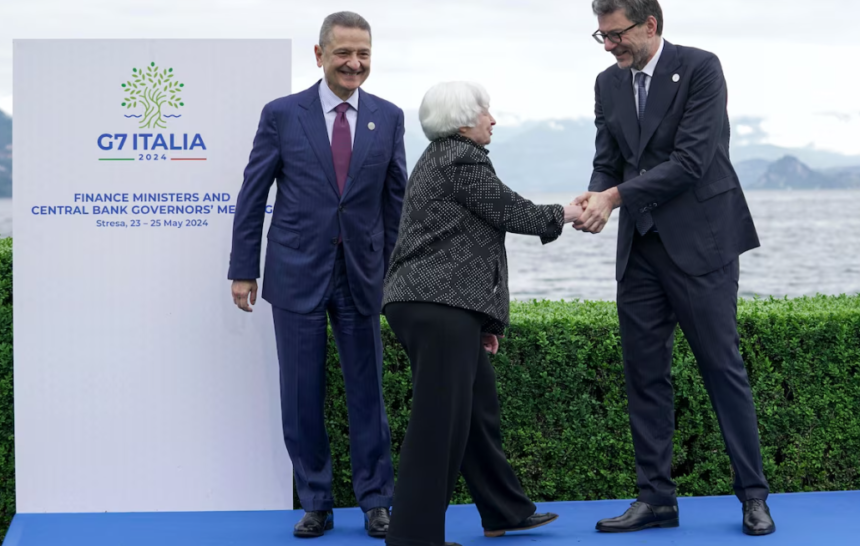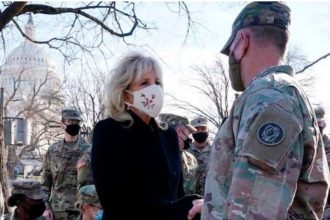Officials from the Kremlin have proposed taking American assets in Russia as payback, though it’s unclear how much of an impact such actions may have.
Moving closer to giving Kyiv another vital source of funding, the United States and its Western allies took a significant step on Saturday toward leveraging frozen Russian assets to support Ukraine’s military effort.
The potential consequence of Russian authorities’ suggestion to seize American and European assets in Russia as a form of retaliation is unknown.
During their meeting in northern Italy last week, the Group of Seven’s senior financial officials decided to help Ukraine by using the investment returns from “immobilized Russian sovereign assets.” After invading Ukraine in 2022, the Kremlin was prevented from accessing hundreds of billions of dollars stored in Western banking institutions. European and American authorities have been debating whether or not to unleash these money to aid in fending off the invasion for months.
Russia has some $280 billion in sovereign assets, mostly owned by European companies, hidden away in Western financial institutions. The sanctions campaign spearheaded by the United States has now blocked such money.
According to the proposed strategy, the Western allies would basically pay themselves back for the money they provide to Ukraine in the near future using the interest and other investment returns that would accrue on these assets. Finance executives are sorting through a maze of intricate legal and financial issues, and the precise amount of money that may be obtained in this manner may vary based on interest rates and other financial factors.
Though there are still some important elements to iron out, Western officials estimate that the proposal might bring in as much as $50 billion in short- or medium-term investment for Ukraine. At later G-7 meetings in Italy this June, President Biden and the other heads of state hope to confirm the proposal. After months of impasse brought on by House Republicans, Congress this month authorized $95 billion in foreign military aid; but, advocates of Ukraine are looking to additional sources of money to fulfill Kyiv’s significant long-term financial requirements.
“In line with international law and our respective legal systems, we are making progress in our discussions on potential avenues to bring forward the extraordinary profits stemming from immobilized Russian sovereign assets to the benefit of Ukraine,” the statement reads.
Supporters of Ukraine first demanded that all Russian sovereign assets be seized and transferred to Kyiv. However, that idea was abandoned when Germany, France, and other allies of the United States voiced concerns about it, believing that it would force investors to move their money elsewhere and jeopardize the financial stability of the euro zone. The basic assets of Russia would remain unaltered by the new strategy. Earlier this month, the European Union also decided to proceed with spending the proceeds from the frozen Russian assets.
Russia has vehemently denounced as a breach of international law any attempt to seize or use its financial assets for other purposes. On Thursday, President Vladimir Putin signed an order allowing the seizure of property owned by American individuals and businesses in Russia.
Supporters of Ukraine first demanded that all Russian sovereign assets be seized and transferred to Kyiv. However, that idea was abandoned when Germany, France, and other allies of the United States voiced concerns about it, believing that it would force investors to move their money elsewhere and jeopardize the financial stability of the euro zone. The basic assets of Russia would remain unaltered by the new strategy. Earlier this month, the European Union also decided to proceed with spending the proceeds from the frozen Russian assets.
Russia has vehemently denounced as a breach of international law any attempt to seize or use its financial assets for other purposes. On Thursday, President Vladimir Putin signed an order allowing the seizure of property owned by American individuals and businesses in Russia.
“They appear to be exercising caution; they recognize the risks associated with these choices as well as the unavoidable repercussions for themselves. According to Reuters, Kremlin spokesperson Dmitry Peskov told reporters earlier this week, “That is why they have gone for the smaller option.” “To us, however, even the more limited option is equivalent to expropriation.”
However, hundreds of American and European businesses have already left the nation in reaction to Russia’s invasion of Ukraine and the sanctions that followed. Approximately 400 of the 1,600 foreign companies who were doing business in Russia prior to the invasion are still there, and just thirty American companies are still there, according to Yale School of Management professor Jeffrey Sonnenfeld. Calling the Kremlin’s threat, Sonnenfeld
U.S. attempts to convince European partners to use the confiscated sovereign Russian assets have been spearheaded by Treasury Secretary Janet L. Yellen. Yellen has cited Kyiv’s long-term finance requirements as well as the projected losses caused by Moscow’s conflict against its neighbor, believed to be in the hundreds of billions of euros. In addition, even in the event that Biden is not elected president in November, the monies may assure that Ukraine continues to receive assistance from the West.
Yellen told reporters earlier this week, “This is an assured source of financing.” “It’s critical that Russia understand that our lack of resources will not stop us from supporting Ukraine.”















